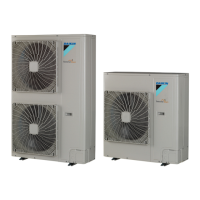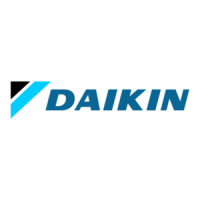6 | Application guidelines
Installer reference guide
25
EKHWET90~120BAV3
R32 Split series – Domestic hot water tank
4P680077-1 – 2021.11
Possible DHW tank volumes
Type Possible volumes
Standalone DHW tank ▪ 90l
▪ 120l
Energy saving tips
▪ If the DHW consumption differs from day to day, you can program a weekly
schedule with different desired DHW tank temperatures for each day.
▪ The lower the desired DHW tank temperature, the more cost effective. By
selecting a larger DHW tank, you can lower the desired DHW tank temperature.
▪ The heat pump itself can produce domestic hot water of maximum 53°C (or
lower according to outdoor temperature). The electrical resistance integrated in
the tank can increase this temperature. However, this consumes more energy.
We recommend to set the desired DHW tank temperature below 53°C to
minimize using the electrical resistance.
▪ In case multiple indoor units are connected to the outdoor unit: when the
heatpump produces domestic hot water (DHW), depending on total demand for
Air Conditioning (A/C) and the scheduled priority setting, it might not be able to
do both DHW and A/C at the same time. In case you need DHW and A/C at the
same, we recommend to produce the domestic hot water during the night when
there is lower A/C demand or during the time when occupants are not present.
6.2.3 Setup and configuration – DHW tank
▪ For large DHW consumptions, you can heat up the DHW tank several times
during the day.
▪ To heat up the DHW tank to the desired DHW tank temperature, you can use the
following energy sources:
- Thermodynamic cycle of the heatpump
- Electrical booster heater
▪ For more information about:
- Optimising the energy consumption for producing domestic hot water, see
"10Configuration"[451].
- Connecting the water piping of the standalone DHW tank to the indoor unit,
see the installation manual of the DHW tank.
6.3 Setting up the power consumption control
You can use the following power consumption controls. For more information
about the corresponding settings, see "Power consumption control"[485].
# Power consumption control
1 "6.3.1Permanent power limitation"[426]
▪ Allows you to limit the power consumption of the entire heat pump
system (sum of outdoor unit, indoor unit and booster heater) with one
permanent setting.
▪ Limitation of power in kW or current in A.

